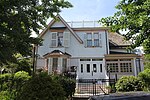Murray Hill station (LIRR)
1889 establishments in New York (state)Long Island Rail Road stations in New York CityRailway stations in Queens, New YorkRailway stations in the United States opened in 1889Railway stations in the United States opened in 1914 ... and 1 more
Use mdy dates from September 2019

Murray Hill is a station on the Long Island Rail Road's Port Washington Branch in the Murray Hill subsection of Flushing in Queens, New York City. The station is part of CityTicket. The station is located beneath 150th Street and 41st Avenue, just south of Roosevelt Avenue.
Excerpt from the Wikipedia article Murray Hill station (LIRR) (License: CC BY-SA 3.0, Authors, Images).Murray Hill station (LIRR)
41st Avenue, New York Queens
Geographical coordinates (GPS) Address Nearby Places Show on map
Geographical coordinates (GPS)
| Latitude | Longitude |
|---|---|
| N 40.762703 ° | E -73.814446 ° |
Address
41st Avenue
11354 New York, Queens
New York, United States
Open on Google Maps









